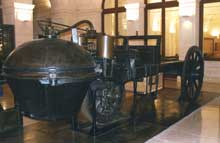The French had a word for it: “automobile,” combining Greek and Latin roots, though it was initially used as an adjective, as in voiture automobile (self-propelled conveyance). First used around 1890, the term did not catch on in the United States until 1899, when it replaced “motocycle;” in Britain “motor car” was preferred and still is, to some extent, today. The French needed a word because they had a motor industry, starting in 1883 with Count Albert DeDion, who teamed with Georges Bouton and M. Trepardoux to build steam cars. By the turn of the Twentieth Century there was a vibrant industry, including steam proponent Serpollet (1887, later Gardner-Serpollet), and internal combustion pioneers Panhard et Levassor (1889), Peugeot (also 1889 and still going), Delahaye (1894) and johnny-come-lately Renault (1898).
Moreover, the French have an enduring claim on the invention of the automobile, at least as we define it. Nicolas-Joseph Cugnot, a retired Army officer, was given a contract in 1769 to build a steam-powered tractor for towing artillery. His first voiture en petite was demonstrated the following year and carried four people at a walking pace, but could only run for 15 minutes before running out of steam.
That same year he began building another, tested in 1771. This was a tricycle some 24 feet in length, with a huge kettle of a boiler cantilevered over the single front wheel. Twin vertical cylinders operated directly on the wheel, their connecting rods alternately operating ratchets on the axle. A two-handed tiller operated a simple steering gear, and a long rod controlled the speed by modulating steam leaving the boiler. Slung below the chassis was a wicker fuel tank, containing chunks of wood. Though crude by today’s standards, including a total lack of brakes, it was forward-thinking in use of front-wheel drive and rack-and-pinion steering.
The fardier à vapeur (steam dray) operated on the streets of Paris, though the legends have gained in the telling. Conventional wisdom says it belched and snorted through the streets, terrorizing the good citizens, before knocking down a wall, whereupon the machine was seized and its inventor thrown into jail. Montagu and Bird dismiss the latter claims as “flights of purest fancy,” while admitting that the tradition concerning the wall is “strong” and might have resulted in some “trifling damage.”
What is perhaps most remarkable is that this mother of the motor car survives, on display at Musée des Arts et Métiers in Paris. Much of it has been reconstructed, but the boiler and firebox are clearly original, nicely patinated and fragile in places. Its silhouette adopted as the emblem of the Society of Automotive Historians, you’d think that carfolk would be ten deep in paying homage, but on the day some friends and I visited in 2001 we had the fardier all to ourselves, save for the occasional browsing schoolboy.

